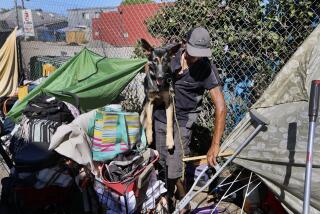Homelessness in L.A.: Cleaning up skid row the right way
- Share via
For much of the last decade, Los Angeles city officials and advocates for the homeless have clashed in and out of state and federal court over attempts to “clean up” downtown’s skid row.
In April, that battle heated up again when advocates sued the city, accusing police and the Bureau of Street Services of violating the constitutional rights of eight homeless men whose property — including carts, tents and other personal items — had been seized and dumped when they briefly left to eat, use a bathroom or appear in court.
And last week, U.S. District Judge Philip S. Gutierrez reached the absolutely correct conclusion when he issued a temporary injunction against the city that bars sanitation workers and police from seizing or destroying the property of homeless people left unattended on skid row.
So far, so good. But now, City Atty. Carmen Trutanich’s office says it wants a jury to decide whether the city should have to pay damages to the eight men.
That’s unnecessary — a waste of time and resources. It does not require a federal judge and a jury trial to determine what should happen next. The city should pay reasonable damages, which will not exceed several thousand dollars per plaintiff. That may seem like a lot of money for a few men who have nothing. But for the homeless, those tents and carts and their contents — which in this case included identification cards, medications and family photographs — are worth much more than most of us can imagine. Those small items represent access to much-needed public services or reminders of lives left behind.
As for the broader issues, Gutierrez’s ruling temporarily resolves a fight between advocates and city officials that so far has produced no winners.
It’s unclear how many men, women and children are stuck on skid row — estimates vary from a few hundred on any given night to nearly 4,000, depending on whom you ask. Frankly, any number is too great when you consider that those living in that area of downtown are among the city’s most vulnerable. About 90% of the homeless suffer from physical or mental disabilities or are battling addiction, according to a 2009 county report, the most recent available.
City officials and advocates should sit down and work out a plan to address the issue of unattended property. Together, they should appoint a liaison to help police and public works employees determine what is rubbish and what belongs to those for whom the loss of even the smallest item can cause real harm.
More to Read
A cure for the common opinion
Get thought-provoking perspectives with our weekly newsletter.
You may occasionally receive promotional content from the Los Angeles Times.









